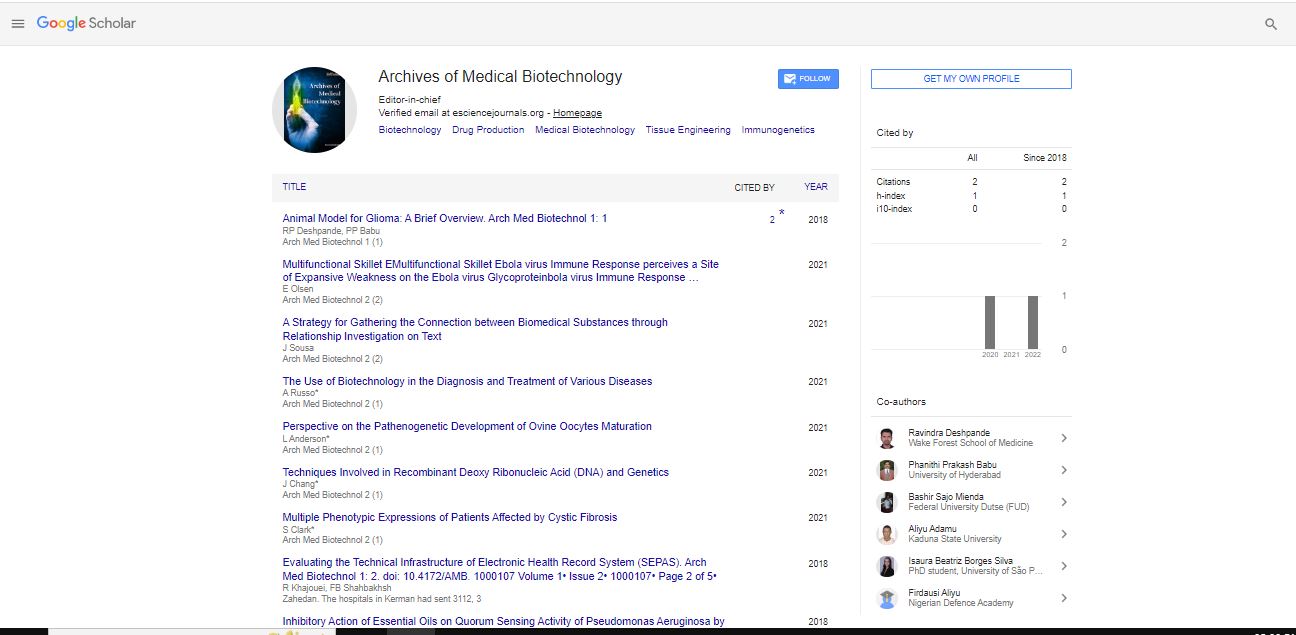Opinion Article, Arch Med Biotechnol Vol: 4 Issue: 1
Biomimetic Approaches to Tissue Engineering: Mimicking Nature for Tissue Repair
Marwa Elnahas*
1Department of Medical Laboratory Sciences, College of Science, Al Balqa Applied University, As-Salt, Jordan
*Corresponding Author: Marwa Elnahas
Department of Medical Laboratory
Sciences, College of Science, Al Balqa Applied University, As-Salt, Jordan
E-mail: elnahasm@bau.edu.jo
Received date: 14 February, 2023, Manuscript No. AMB-23-95727;
Editor assigned date: 16 February, 2023, PreQC No. AMB-23-95727 (PQ);
Reviewed date: 03 March, 2023, QC No. AMB-23-95727;
Revised date: 10 March, 2023, Manuscript No. AMB-23-95727 (R);
Published date: 20 March, 2023, DOI: 10.4172/amb.1000036.
Citation: Elnahas M (2023) Biomimetic Approaches to Tissue Engineering: Mimicking Nature for Tissue Repair. Arch Med Biotechnol 4:1.
Description
Tissue engineering is an interdisciplinary field that aims to produce functional biological tissues using a combination of cells, biomaterials, and bioactive molecules. The ultimate goal of tissue engineering is to develop therapeutic strategies for the regeneration or replacement of damaged or diseased tissues. However, the complexity of biological tissues presents a significant challenge for tissue engineering. Thus, researchers have turned to nature for inspiration and developed biomimetic approaches to tissue engineering, which mimics the structure and function of natural tissues.
Biomimetic approaches to tissue engineering are based on the principle that biological tissues are hierarchical structures composed of different levels of organization, from the molecular to the macroscopic level. Therefore, biomimetic tissue engineering aims to replicate the hierarchical organization of natural tissues by using biomaterials and bioactive molecules that mimic the Extracellular Matrix (ECM) and the signals that regulate cell behavior. The ECM is a complex network of proteins and carbohydrates that provides structural support and biochemical cues to cells.
One of the key challenges in tissue engineering is to provide an appropriate environment for the seeded cells to proliferate, differentiate, and form functional tissue. Therefore, researchers have developed biomimetic scaffolds that mimic the ECM's composition and mechanical properties to provide a suitable microenvironment for the seeded cells. These scaffolds can be fabricated using a variety of techniques, such as electrospinning, freeze-drying, and 3D printing. Moreover, the scaffolds can be functionalized with bioactive molecules, such as growth factors and cytokines, to enhance cell behavior and tissue regeneration.
Biomimetic approaches to tissue engineering also involve the use of biomimetic cues to regulate cell behavior. For example, cells in natural tissues receive signals from the ECM, neighboring cells, and soluble factors that regulate their proliferation, differentiation, and migration. Therefore, researchers have developed biomimetic cues, such as bioactive molecules and physical cues, to regulate cell behavior in tissue-engineered constructs. Bioactive molecules, such as growth factors, cytokines, and extracellular matrix proteins, can be incorporated into the biomaterials or released from the scaffolds to enhance cell behavior. Physical cues, such as topography, stiffness, and electrical stimulation, can also be used to modulate cell behavior and tissue regeneration.
Biomimetic approaches to tissue engineering have been used to develop tissue-engineered constructs for a variety of tissues, including bone, cartilage, skin, and blood vessels. For example, biomimetic scaffolds have been used to regenerate bone tissue by mimicking the ECM's composition and mechanical properties. Moreover, biomimetic cues, such as growth factors and mechanical loading, have been used to enhance bone cell behavior and tissue regeneration. Similarly, biomimetic scaffolds and cues have been used to regenerate cartilage tissue by mimicking the ECM's composition and biomechanical properties. Furthermore, biomimetic approaches have been used to develop skin substitutes for the treatment of burns and chronic wounds. These skin substitutes mimic the ECM's composition and structure and are functionalized with bioactive molecules to enhance tissue regeneration.
Biomimetic approaches to tissue engineering also have the potential to revolutionize the field of regenerative medicine by providing personalized therapies for patients. For example, biomimetic scaffolds can be fabricated using a patient's own cells to develop tissueengineered constructs that are immunologically compatible with the patient's body. Moreover, biomimetic cues can be tailored to the specific needs of the patient's tissue, such as the use of growth factors to enhance tissue regeneration or physical cues to promote tissue remodeling.
Conclusion
In conclusion, biomimetic approaches to tissue engineering hold great potential in addressing the challenges of tissue repair and regeneration. By mimicking the structure and function of natural tissues, researchers have been able to develop biomimetic scaffolds and cues that provide suitable microenvironments for seeded cells to proliferate, differentiate, and form functional tissues. These biomimetic approaches have been successful in regenerating bone, cartilage, skin, and blood vessels, among other tissues, and have the potential to revolutionize regenerative medicine by providing personalized therapies for patients. While there are still challenges to overcome, such as scaling up production and ensuring long-term functionality, biomimetic approaches to tissue engineering offer a promising future for tissue repair and regeneration.
 Spanish
Spanish  Chinese
Chinese  Russian
Russian  German
German  French
French  Japanese
Japanese  Portuguese
Portuguese  Hindi
Hindi 